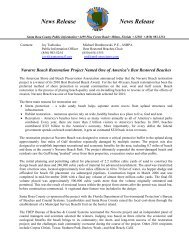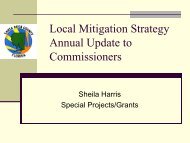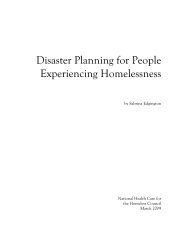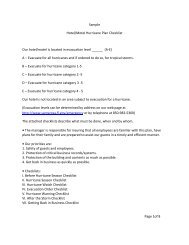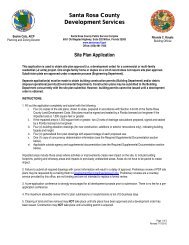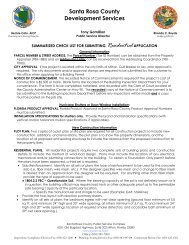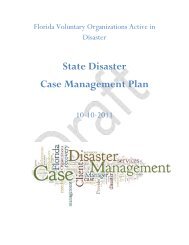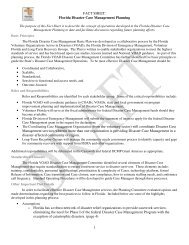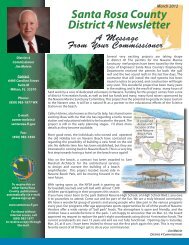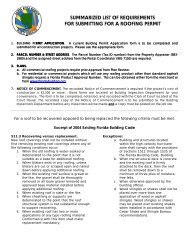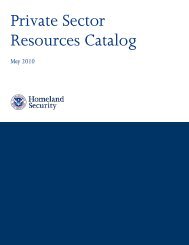NOLF CHOCTAW JLUS - Santa Rosa County, Florida, Economic ...
NOLF CHOCTAW JLUS - Santa Rosa County, Florida, Economic ...
NOLF CHOCTAW JLUS - Santa Rosa County, Florida, Economic ...
Create successful ePaper yourself
Turn your PDF publications into a flip-book with our unique Google optimized e-Paper software.
DRAFT.CHAPTER 3<strong>NOLF</strong> <strong>CHOCTAW</strong> <strong>JLUS</strong>Primary AirfieldUseRunwayCapabilityTime of UseOther UsesPlanned UsesStudy AreaPopulationExecutive SummaryFixed-wing prop and turbo-prop aircraftflight training and home of the unmannedaerial vehicle (UAV) PioneerFixed-wing jet, prop, or turbo-propaircraft; UAV; rotary-wingDay or night use; year-roundBlue Angel jet practice in Choctawairspace; helicopter training; specialforces training ops; field carrier landingpractice (FCLP)JPATS solo airfield; expanded UAVtraining; armored vehicle maintenance onnearby Eglin Air Force Base.Current Potential167 9,598Study Area Issues and General RecommendationsMost areas north and east of the airfield cannot be developedbecause land is under public ownership. Land characteristicsin south and west sectors exhibit great potential for landacquisition. <strong>Florida</strong> Forever projects have been developed toacquire most lands to the west and southwest. Current LDRland use designation assigned to property south of airfieldpromotes densities incompatible with current and futuremilitary activities. Access to large vacant parcels is onlypossible through Eglin Air Force Base property.Map3-1Recommendations emphasize land acquisition and land usedensity reduction focused on areas south of the airfield.Chapter ContentsSection 1 Introduction and Study Background1.1 Study Purpose1.2 <strong>NOLF</strong> Choctaw Location1.3 Choctaw Study AreaSection 2 Airfield Operations and Navy Growth Objectives2.1 Airfield Use and Mission – Current and Future2.2 Facilities and Aircraft2.3 Airfield Operations and Procedures2.4 Current Air Operation ConflictsSection 3 Community Profile and DevelopmentCharacteristics3.1 Study Area Profile3.2 Current Housing and Population3.3 Clear Zone/Accident Potential Zone (APZ)Profile3.4 Noise Zone Profile3.5 Summary of Existing Airfield and Land UseConflictsSection 4 Future Development Potential and Assessment ofFuture Land Use Conflicts4.1 Housing and Population Methodology4.2 Study Area Development Potential4.3 APZ and Noise Zone Development Potential4.4 Other Development IssuesSection 5Study RecommendationsAppendix 3A <strong>NOLF</strong> Choctaw <strong>JLUS</strong> MapsAppendix 3B FiguresAppendix 3C Glossary of Military Aircraft Using <strong>NOLF</strong>ChoctawNote: with exception to Map 3-1 above, maps referenced inthis chapter are placed in Appendix 3A located in the back ofthis chapter.<strong>Santa</strong> <strong>Rosa</strong> Joint Land Use Study<strong>Santa</strong> <strong>Rosa</strong> <strong>County</strong> and NAS Whiting Field3-1
September 2003CHAPTER 3: <strong>NOLF</strong> <strong>CHOCTAW</strong>1.1 Study PurposeSECTION 1INTRODUCTION AND STUDY BACKGROUNDIn 1973, the United States Department of Defense (DoD) created the Air Installation Compatible UseZones (AICUZ) program to encourage local governments to manage growth and development in amanner compatible with present and future military installation operations. The program evaluatesexisting land uses, identifies potential conflicts between growth and military operations, and offersrecommendations for compatible growth patterns. Program emphasis is placed on areas mostsusceptible to noise impacts and safety concerns associated with military operations. To accomplishthis program objective, noise contours and accident potential zones have been established for allmilitary airfields, including Naval Air Station (NAS) Whiting Field (North and South) and its fourteenNavy Outlying Landing Fields (<strong>NOLF</strong>) which includes <strong>NOLF</strong> Choctaw.The Commanding Officer at NAS Whiting Field recognizes that any successful plan to realizecompatible growth near airfields requires involvement by the <strong>Santa</strong> <strong>Rosa</strong> <strong>County</strong> Board of <strong>County</strong>Commissioners (BCC). While NAS Whiting Field can manage military activity at its airfields, theBCC holds authority to manage land use and development on properties outside of militaryinstallations and within unincorporated <strong>Santa</strong> <strong>Rosa</strong> <strong>County</strong>. By working together, mutually acceptablegrowth management strategies can be developed to avoid conflicts between NAS Whiting Field’smission and <strong>Santa</strong> <strong>Rosa</strong> <strong>County</strong>’s desired growth patterns and quality of life.This joint endeavor involves a two-step process. Once a joint land use study (<strong>JLUS</strong>) has identifiedcompatible land uses and growth management guidelines, the second step will involve formation ofspecific development regulations and land management implementation programs. This reportaddresses the first step -- a joint land use study. All together, a <strong>JLUS</strong> has been prepared for seven (7)US Navy (USN) airfields (North and South combined) and the <strong>County</strong> Airport, Peter Prince Field.These eight (8) separate and distinct studies comprise the <strong>Santa</strong> <strong>Rosa</strong> <strong>JLUS</strong>. The seven (7) USNinstallations evaluated in the <strong>Santa</strong> <strong>Rosa</strong> <strong>JLUS</strong> are NAS Whiting Field (North and South) and six (6) ofits fourteen (14) <strong>NOLF</strong>s; Choctaw, Harold, Holley, Pace, <strong>Santa</strong> <strong>Rosa</strong>, and Spencer. This chapteraddresses only <strong>NOLF</strong> Choctaw.1.2 <strong>NOLF</strong> Choctaw Location<strong>NOLF</strong> Choctaw is located approximately two (2) miles east and north of East Bay and two (2) mileswest of State Road 87. Access to the field is from State Road 87. The general location of <strong>NOLF</strong>Choctaw as well as its proximity to other airfields in <strong>Santa</strong> <strong>Rosa</strong> <strong>County</strong> is shown in Map 1-1 ofChapter 1. Situated approximately thirteen (13) miles south-southeast of NAS Whiting Field, <strong>NOLF</strong>Choctaw's location places it on Eglin Air Force Base property but underneath Navy-managed airspace.The US Navy has a long-term agreement with the US Air Force to use <strong>NOLF</strong> Choctaw on conditionthat it is used for flight training. <strong>NOLF</strong> Choctaw is located at the southwestern edge of Eglin AirForce Base.<strong>Santa</strong> <strong>Rosa</strong> Joint Land Use Study<strong>Santa</strong> <strong>Rosa</strong> <strong>County</strong> and NAS Whiting Field3-2
September 2003CHAPTER 3: <strong>NOLF</strong> <strong>CHOCTAW</strong>1.3 Choctaw Study AreaThe study area boundaries for <strong>NOLF</strong> Choctaw <strong>JLUS</strong> (hereafter Choctaw Study Area) are illustrated onMap 3-1, which is located in the first page of this chapter. The Choctaw Study Area covers 29 squaremiles south of the Yellow River and east and north of East Bay. All property within the ChoctawStudy Area is situated within unincorporated <strong>Santa</strong> <strong>Rosa</strong> <strong>County</strong> and not within any municipalboundaries.The Choctaw Study Area includes all areas adjacent to military property specifically designated asAccident Potential Zones or located within Noise Level Contours, both of which were established bythe existing Air Installation Compatibility Use Zones (AICUZ) study for <strong>NOLF</strong> Choctaw. To takeinto consideration lands outside the AICUZ that may also be affected by military operations, studyboundaries were expanded to encompass non-military lands generally located two and one-half milesfrom the airfield. The study area boundary was adjusted to utilize natural features, such as rivers orwaterbodies, near its perimeter.The <strong>NOLF</strong> Choctaw <strong>JLUS</strong> presented in the chapter emphasizes evaluation of non-military lands withinits study area boundaries. The largest in geographical size among the eight study areas, ChoctawStudy Area covers 18,816 acres, or approximately 29 square miles. Only 5,497 acres compose nonmilitaryproperty. Acreage for the Choctaw Study Area is shown in Table 3-1 according to study areacomponents. Note that acreage for the total study area will not equal a summation of its components.This anomaly occurs because some areas in the Noise Level Zone overlap with the Accident PotentialZone, creating a double counting of acreage if sub-categories are added together. Also note that bothcurrent and proposed Noise Level Zones are evaluated in this chapter. Noise counters for <strong>NOLF</strong>Choctaw are being evaluated by NAS Whiting Field.Table 3-1Study Area ComponentsComponentAcresTotal Study Area (Map 3-1) 18,816Non-Military Property 5,397Noise Level Zone (Current) 471Noise Level Zone (Proposed) 669Clear Zone/Accident PotentialZone1,065Clear Zone “A” 0APZ-I “B” 491APZ-II “C” 574Military 13,419A. Clear Zones (Class B) Aviation history has shown that property along primary flight pathsand immediately beyond the ends of runway have a higher potential exposure to aircraft accidentsthan areas further out from an airfield or flight path. Created as part of the AICUZ program, ClearZones are intended to delineate areas exposed to higher risk. Intended to serve as guidelines only,Clear Zones function to heighten the general public’s awareness to areas where higher risks occur.<strong>Santa</strong> <strong>Rosa</strong> Joint Land Use Study<strong>Santa</strong> <strong>Rosa</strong> <strong>County</strong> and NAS Whiting Field3-3
September 2003CHAPTER 3: <strong>NOLF</strong> <strong>CHOCTAW</strong>The Clear Zone is an area that possesses a high potential for accidents and is located just past theend of a runway. It has been labeled “A” to enable easier depiction on maps.B. Accident Potential Zones. (CLASS B) Beyond the Clear Zone is an area along the flight paththat possesses a significant potential for accidents. Created as part of the AICUZ program,Accident Potential Zones (APZ) are intended to delineate areas exposed to higher risk. Intendedto serve as guidelines only, APZs function to heighten the general public’s awareness to areaswhere higher risks occur. They also help local governments to identify where to direct zoningregulations and land use standards designed to reduce potential conflicts between airfieldoperations and civilian populations.Accident Potential Zones (APZ's) are divided into two (2) designations based on accident potential.The zone closest to the Clear Zone is referred to as APZ-I. It has been labeled “B”. APZ-II(labeled “C”) is typically furthest from the runway in terms of the flight path and it has ameasurable potential for accidents. Approach or departure flight paths will turn into or away froma runway. Therefore, APZ’s I and II may curve away from the end of a runway as well has leadingstraight out. Based on designated airport flight paths for approach and departure, some areas in aAPZ-II zone may actually be closer to a runway than portion of the APZ-I. Figure 3-1 inAppendix 3B provides a diagram further describing the organization and application of APZs forhelicopters and fixed-wing aircraft.<strong>NOLF</strong> Choctaw operates as a multi-use airfield capable of serving fixed-wing (i.e., airplanes) androtary-wing (i.e., helicopter) aircraft. Fixed-wing aircraft must use runways for landing and takeoff.Both Fixed wing and rotary wing aircraft typically arrive or depart an airfield facing into thewind. The APZ designations (Class B airfield) for <strong>NOLF</strong> Choctaw are larger than those associatedwith NAS Whiting Field and <strong>NOLF</strong> Holley which are considered Class A airfields. Helicoptertraffic is a small percentage of the total traffic and helicopter APZ’s are not designated for this<strong>NOLF</strong>. Flight paths for helicopters taking-off or landing will vary based on wind direction and airtraffic. Operating procedures established by NAS Whiting Field direct helicopters to arrive orleave the field on a north or south pattern under normal weather or air traffic conditions. Based onwind direction or air traffic, the helicopter flight paths may not always overlap with the designatedAPZ.C. Noise Level Zone. In addition to addressing safety concerns, the AICUZ also addresses noiseexposure to non-military lands near military installations. Noise exposure can create conflicts withpublic welfare and quality of life for those living or working near airfields. For the <strong>NOLF</strong>Choctaw <strong>JLUS</strong>, noise level contours extending from the airfield are incrementally measured fromthe highest typical decibel (dB) generated within a military installation to 55 dB within nonmilitaryproperty. Within the Choctaw Study Area, non-military lands inside the 55 dB contourare referred to as the Noise Zone.Similar to aircraft operational conditions described above for APZs, helicopters must faceoncoming wind to create optimal conditions for safe take-off and landing. Subject to aerodynamicwind effects, landing and take-off flight paths for helicopters experience wider variations thanflight paths for fixed-wing aircraft, which must be aligned with a runway. Helicopter approach and<strong>Santa</strong> <strong>Rosa</strong> Joint Land Use Study<strong>Santa</strong> <strong>Rosa</strong> <strong>County</strong> and NAS Whiting Field3-4
September 2003CHAPTER 3: <strong>NOLF</strong> <strong>CHOCTAW</strong>departure to and from an airfield follow pre-determined flight paths referred to as the “normalflight path.” Deviation from a normal helicopter flight path occurs to take advantage of safer flightpaths created by wind direction or to accommodate air traffic. Noise patterns for helicopters canvary for the dynamic conditions stated. A Noise Zone for helicopters must allow for moreflexibility than that for fixed-wing aircraft because of aerodynamic and safety requirements.<strong>Santa</strong> <strong>Rosa</strong> Joint Land Use Study<strong>Santa</strong> <strong>Rosa</strong> <strong>County</strong> and NAS Whiting Field3-5
September 2003CHAPTER 3: <strong>NOLF</strong> <strong>CHOCTAW</strong>SECTION 2AIRFIELD OPERATIONS AND NAVY GROWTH OBJECTIVESThis section inventories and analyzes current air and ground operations performed at <strong>NOLF</strong> Choctaw.Any current conflicts with military operations, whether air or ground, are also identified and described.2.1 Airfield Use and Mission – Current and FutureOne (1) of fourteen (14) <strong>NOLF</strong>s supporting NAS Whiting Field, <strong>NOLF</strong> Choctaw performs a widerange of flight and ground training activities for the US Navy and other military branches.Functioning as a tower-controlled field jointly used for fixed-wing and rotary-wing flight training,<strong>NOLF</strong> Choctaw’s primary mission is to support NAS Whiting Field for primary flight training to Navy(USN), Marine (USMC), Coast Guard (USCG), Air Force (USAF), foreign forces, and other fixedwingflight students. The field is also the home of the U.S. Navy’s unmanned aerial vehicles (UAV)training facility. <strong>NOLF</strong> Choctaw is used for day and evening training or practice exercises. Fixedwingand helicopter training may both occur at <strong>NOLF</strong> Choctaw during the same hours. As thisairfield serves multiple purposes, different types of aircraft and ground training may simultaneouslytake place. Albeit, activities are assigned to designated areas, courses, and schedules by NAS WhitingField and monitored by Choctaw Tower.Other flight-related activities taking place at Choctaw Field include performance and maneuverpractice by the Navy’s Flight Demonstration Squadron -- the Blue Angels – as well as field carrierlanding practice. Stationed at their home at nearby NAS Pensacola, the Blue Angels routinely practicein <strong>NOLF</strong> Choctaw airspace with their FA-18 Hornet jet aircraft. Helicopter flight training supportingNAS Whiting Field also occurs at this field, but other <strong>NOLF</strong>s accommodate a greater share of primaryand advanced helicopter (rotary-wing) flight training operating out of NAS Whiting Field.Field carrier landing practice (FCLP) is a training exercise designed to simulate landing on an aircraftcarrier at sea. The exercise typically involves small groups of aircraft flying in a local pattern around<strong>NOLF</strong> Choctaw to practice touch-and-go landings to a simulated aircraft carrier deck painted at eachend of runway 18/36. These landing areas also have lighting for use at night. . A number of flightsquadrons from the USN, USAF, and other military branches use <strong>NOLF</strong> Choctaw’s facilities. Navysquadrons, VAQ-129 (EA-6) and VAW-120 (E-2 and C-2) squadrons regularly use <strong>NOLF</strong> Choctawand the FCLP facilities. The VAQ-129 serves the USN as a tactical electronic attack squadron, whilethe VAW-120, Carrier Airborne Early Warning Squadron, functions as the “eyes of the fleet”performing early warning and detection supporting the USN fleet and installations. Additionally,VMFA 142 (USMC) uses the FCLP facilities to conduct their training in the F-18 aircraft. ChoctawField has facilities to conduct both day and night FCLP’s.Flight training at Choctaw Field and surrounding Eglin Air Force Base property support special forcetraining as well. Ground operations associated with these activities can include use of heavy or lightarmored vehicles and helicopters. Live ammunition is not used to conduct these military operations.While <strong>NOLF</strong> Choctaw’s mission for future years will continue to support current flight trainingactivities as well as those activities previously described, NAS Whiting Field and the US Navy will<strong>Santa</strong> <strong>Rosa</strong> Joint Land Use Study<strong>Santa</strong> <strong>Rosa</strong> <strong>County</strong> and NAS Whiting Field3-6
September 2003CHAPTER 3: <strong>NOLF</strong> <strong>CHOCTAW</strong>increasingly rely upon the availability of <strong>NOLF</strong> Choctaw to perform additional roles andresponsibilities.<strong>NOLF</strong> Choctaw will play an important role in the Joint Primary Aircraft Training System (JPATS) 1 ,which is a set of primary flight training devices designed to meet USN and USAF aircrewrequirements. The principal JPATS mission is to train entry-level USN/USAF student pilots in primaryflying skills to a level of proficiency enabling them to transition into an advanced pilot training pathleading to qualification as military pilots, navigators, and Flight Officers. Implementation of JPATSwill result in the replacement of the USN T-34C aircraft and its supporting ground-based trainingsystems (GBTS) currently applied at NAS Whiting Field. The T-6A has already started replacing theT-34 aircraft at NAS Pensacola. These aircraft train Flight Officers and will use <strong>NOLF</strong> Choctaw fortouch and go training. While the GBTS equipment will be placed at NAS Whiting Field, ChoctawField will primarily be used to practice touch and go landings and other flight training for aviationstudents in the new T-6A fixed-wing planes. NAS Whiting Field has construction plans to reconstructone of <strong>NOLF</strong> Choctaw’s runways for T-6A operations.UAV operations at <strong>NOLF</strong> Choctaw are expected to increase. Preliminary investigations are underwayto determine if a UAV runway closer to Highway 87 would better serve the needs of the Navy and theAir force.To support ground troop operations, the US Marine Corp and the Alabama Guard have plans to placean armored tank maintenance facility on Eglin Air Force Base property just east of the airfield butinside the <strong>NOLF</strong> Choctaw Study Area.2.2 Facilities and AircraftFacilities at <strong>NOLF</strong> Choctaw include a primary runway 8,000 feet in length with standard airfieldlighting and approach lights, taxi way and parking aprons, a control tower and landing signal officerbuilding, and facilities for fire and rescue ground crews. Runway arresting gear 2 is available, but iscurrently in layup. Extensive work would be required if the arresting gear were to be needed. Theairfield is set up for 24-hour operation. As stated earlier, to accommodate the FCLP, runway lightinghas been installed at both ends of the runway to simulate an aircraft carrier landing platforms (i.e.,called a lighted carrier box). <strong>NOLF</strong> Choctaw has the ground facilities to support both day and nightoperations.A variety of aircraft, both fixed-wing and helicopter, rely on Choctaw Field to train and prepare flightstudents and experienced USN aviators. Aircraft most frequently seen at Choctaw Field include USNT-34C, TH-57, AV-8, C-130, EA-6B, F-18, T-2, T-6A, T-44, and T-45. Additionally, USAF aircraftknown to use this airfield on occasion for training purposes include the H-60, H-53, C-5, C-17 and C-130. Appendix 3C provides illustrations of military aircraft that most frequently use <strong>NOLF</strong> Choctaw.12JPATS components consists of the T-6A Texan II turboprop aircraft, simulators and associated ground-based training devices, atraining integration management system, instructional courseware, and contractor logistics support.Runway arresting gear is mechanical and hydraulic equipment designed to catch and prevent landing aircraft from running off the endof a runway.<strong>Santa</strong> <strong>Rosa</strong> Joint Land Use Study<strong>Santa</strong> <strong>Rosa</strong> <strong>County</strong> and NAS Whiting Field3-7
September 2003CHAPTER 3: <strong>NOLF</strong> <strong>CHOCTAW</strong>The US Navy has a capital improvement program to schedule and budget infrastructure and equipmentat its military installations and facilities. This program is known as the Military Construction Program,or MILCON and the Special Project Program. In preparation for the JPATS program, MILCON andSpecial Projects include several construction projects to upgrade NAS Whiting Field and some of its<strong>NOLF</strong>s, including <strong>NOLF</strong> Choctaw. Improvements planned at <strong>NOLF</strong> Choctaw include reconstructionof a crosswind runway to accommodate a 5,000-foot runway for the JPATS program. Toaccommodate the expanding UAV program, infrastructure improvements and equipment installationare planned or being planned. Additional resurfacing projects to rebuild the existing runway andtaxiway are planned.2.3 Airfield Operations and Procedures<strong>NOLF</strong> Choctaw conducts both fixed-wing and helicopter operations. Fixed-wing aircraft are normallyassigned to work the western side of the runway while helicopters are directed to the eastern side. Allaircraft are under the direct instruction of the control tower when using <strong>NOLF</strong> Choctaw. Generalaviation practice typically occurs from the surface to 5,000 feet MSL for T-34C fixed-wing and TH-57helicopter. The airspace (Class D) around <strong>NOLF</strong> Choctaw is under the control of the tower.The Commanding Officer of NAS Whiting Field administers policy consistent with all FederalAviation Administration (FAA) Regulations and the Office of the Chief of Naval OperationsInstructions (OPNAVINST’s) procedures regarding safe aviation operations, flight altitudes, and noiseabatement. NAS Whiting Field is sensitive to the effects of noise at all its airfields and their impactson surrounding communities. When appropriate, actions are taken to reduce aircraft noise. Operatingprocedures are in place for fixed-wing and helicopter aircraft to reduce and avoid noise impacts to nonmilitarylands as well as to promote public safety. To this endeavor, operating procedures and policyhave been established to address specific circumstances associated with conditions unique to eachairfield, including the character of the adjacent community.A. Operation Areas and Flight Planning West <strong>Florida</strong> and South Alabama are home to numerousUSN and USAF air bases generating substantial air traffic. The US Navy organizes air space into“areas” Within the FAA designated Alert Area 292. Horizontal (geographic) and vertical (altitude)areas have been established within Alert Area 292 and <strong>NOLF</strong> Choctaw is located in Area 3 of thisarea. The boundaries of Alert Area 292 and Area 3 appear in Map 3-2. To implement safetyobjectives, NAS Whiting Field manages aircraft flight patterns, altitudes, and traffic volumeswithin its control areas through standard operating procedures and authorized flight plans. Allflights must be authorized by a Commanding Officer.Student naval aviators follow trainings programs set forth as part of an approved curriculum.Flight training follows specific flight plans. Fixed-wing aircraft represent a substantial majority offlights using <strong>NOLF</strong> Choctaw, though helicopter training also uses <strong>NOLF</strong> Choctaw at a much lesserdegree. Aircraft originating from a home base other than NAS Whiting Field and NAS Pensacolamust have approval from NAS Whiting Field. All flights entering and departing <strong>NOLF</strong> Choctawairspace must communicate with the tower.B. Flight Patterns. While <strong>NOLF</strong> Choctaw is used for some helicopter training, the field andsurrounding airspace in Area 3 are allocated for fixed-wing training activities for contact (landing<strong>Santa</strong> <strong>Rosa</strong> Joint Land Use Study<strong>Santa</strong> <strong>Rosa</strong> <strong>County</strong> and NAS Whiting Field3-8
September 2003CHAPTER 3: <strong>NOLF</strong> <strong>CHOCTAW</strong>and take-off) and precision aerobatics operations from the surface to 9,500 feet MSL. Among allaircraft using <strong>NOLF</strong> Choctaw airspace, Training Wing FIVE fixed-wing aircraft, typically theT34C, annually comprise the greatest volume of flights using this airfield. Standard operatingprocedures and flight patterns have been established for Training Wing-5 fixed-wing aircraft.Current standard operating procedures are based on the T-34 aircraft requirements. NAS WhitingField will evaluate, and if necessary, revise standard operating procedures to address needs for theT-6A aircraft. The T-6A should not cause any significant modifications to established flightpatterns for fixed-wing training aircraft at <strong>NOLF</strong> Choctaw.1) Fixed-Wing Flight Patterns. Separate flight patterns are established for aircraft entering anddeparting <strong>NOLF</strong> Choctaw airspace. The maximum number of aircraft in any pattern at anygiven time is six.Normal flight patterns for T-34C fixed-wing aircraft entering <strong>NOLF</strong> Choctaw airspace areillustrated on Map 3-3. This flight pattern is called the “Point Avalon” pattern. Flights enterand leave <strong>NOLF</strong> Choctaw airspace in the direction of Point Avalon, which is on the west sideof East Bay. Fixed-wing aircraft approaching <strong>NOLF</strong> Choctaw from the north follow theWeaver River at 900 to 1,200 feet MSL, then turn directly south toward the primary runway.For approaches from the south of <strong>NOLF</strong> Choctaw, aircraft stay within East Bay until south ofthe primary runway, whereupon proceeding directly north toward the airfield.An alternative approach to enter <strong>NOLF</strong> Choctaw airspace is the “High Key” approach. Aircraftapplying the High Key approach enter from any direction but must be at an altitude above2,500 feet MSL until over the airfield.A second flight pattern is used for aircraft involved in touch and go operations, which is atechnique used to practice runway approach. In a touch and go pattern, as many as six aircraftwill circle the airfield. To re-enter the airfield pattern after touching down on the runway, a leftor right turn is made to re-entering the airfield pattern. The normal traffic pattern circling theairfield typically occurs at around 500 feet MSL or as instructed by the field tower. Fixed-wingtraffic patterns are at 900 feet MSL while the break altitude is 1200 feet MSL.Fixed-wing aircraft depart <strong>NOLF</strong> Choctaw to the south at 1,000 feet MSL until over land southof East Bay on Gulf Breeze Peninsula. Aircraft taking-off or flying north at the time ofdeparture will turn to the south and follow the same departure pattern over Gulf BreezePeninsula. Choctaw Tower will determine runway direction for all take-offs.When the Blue Angels use <strong>NOLF</strong> Choctaw’s airspace for precision aerobatics operations, theairfield as well as <strong>NOLF</strong> Holley, is closed to all aircraft. The Blue Angels use airspace fromthe surface to 9,500 feet MSL but primarily use airspace from 5,000 and 9,500 feet MSL.2) Helicopter Flight Patterns. Helicopters approach <strong>NOLF</strong> Choctaw from the north, northwest,or south. For flights entering <strong>NOLF</strong> Choctaw from the north or northwest, flights follow theYellow River until north of the runway, where their heading turns to the south for the airfield.While helicopters arriving from the north (from Point Fish direction) fly at 900 feet MSL,aircraft arriving from the northwest (Yellow River Inlet) fly at 500 feet MSL. Once south of<strong>Santa</strong> <strong>Rosa</strong> Joint Land Use Study<strong>Santa</strong> <strong>Rosa</strong> <strong>County</strong> and NAS Whiting Field3-9
September 2003CHAPTER 3: <strong>NOLF</strong> <strong>CHOCTAW</strong>the Yellow River, helicopters descend to airfield pattern altitude. For helicopter approachesfrom the south of <strong>NOLF</strong> Choctaw, normal altitude is 900 feet MSL. Wind direction andinstruction from Choctaw Tower will determine the most appropriate approach or departurepattern.Helicopters must land or take-off pointed in the direction of the prevailing wind. Winddirection changes based on seasonal and daily cyclical climatic conditions. The assignedcourse, used for takeoff, approach, and taxing will be subject to wind direction. Helicoptersdeparting <strong>NOLF</strong> Choctaw will depart in a northern or southern direction based on the directionof the prevailing wind.Helicopter training at an airfield may require aviation students to perform maneuvers accordingto a course. Flight training activities follow a curriculum approved by the USN Chief of NavalAir Training. The assigned course is predicated by wind direction. For many trainingexercises, the practice course or area on the field will change in conjunction with change inwind direction.C. Flight Operating Procedures and Restrictions. Protection of the health and safety for civilianand military population is a top priority administered and enforced by the USN and NAS WhitingField. To reduce aircraft accident potential, standard operating procedures have been establishedby NAS Whiting Field for flight operations for all its airfields, including <strong>NOLF</strong> Choctaw. Also, toprotect health, safety, and welfare of civilian populations, aircraft may be restricted from operatingwithin certain sensitive areas or below certain altitudes.Fixed-wing aircraft and helicopters have different performance and aerodynamic capabilities.Separate standard operating procedures, have been developed for each type of aircraft. Someoperating standards and restrictions apply uniformly to all types of aircraft. Some procedures andrestrictions may apply to designated geographical areas, such as an airfield or operating area, orsubject to altitude. And some may apply only to specific aircraft types, pilot training level, orcalendar schedule.Any restrictions or procedures applicable to Area 3 will include <strong>NOLF</strong> Choctaw. Restrictions andoperating procedures applicable to aircraft within Area 3 airspace are listed below.1) Area 3 airspace is closed to all traffic when airspace is being used for Navy Blue Angelpractice. (Map 3-2 shows Area 3 boundaries.)2) Fixed-wing aircraft are to avoid airspace below 2,000 feet MSL west of Woodlawn Beachincluding Pensacola Bay and <strong>Santa</strong> <strong>Rosa</strong> Sound. Both areas are outside the <strong>NOLF</strong> ChoctawJoint Land Use Study Area.3) Within Alert Area 292, which includes Area 3 and <strong>NOLF</strong> Choctaw, all aircraft flying below3,000 feet MSL must avoid public beach, resort and noise sensitive areas.4) Fixed-wing aircraft are not allowed to descend below 500 feet above ground level unless whennecessary for takeoff or landing. (Map 3-2 shows Alert Area 292 and Area 3 boundaries.)5) During day or night 1 , helicopter traffic can fly between the surface and 1,399 MSL in Area 3.Helicopter traffic in East Bay should stay below 500 feet MSL whenever practicable, and must1 Night operations begin at official sunset and end at official sunrise.<strong>Santa</strong> <strong>Rosa</strong> Joint Land Use Study<strong>Santa</strong> <strong>Rosa</strong> <strong>County</strong> and NAS Whiting Field3-10
September 2003CHAPTER 3: <strong>NOLF</strong> <strong>CHOCTAW</strong>fly no closer than 500 feet slant-range from any residential building in the East Bay area and atleast 200 yards from the East Bay shoreline. Other altitude restrictions apply for entry anddeparture from <strong>NOLF</strong> Choctaw.6) No more than six (6) aircraft are allowed in the Choctaw airport pattern (i.e., the local pattern)at any given time.2.4 Current Air Operation ConflictsAir and ground operations conducted at <strong>NOLF</strong> Choctaw have a minimal impact on non-military landswithin the Choctaw Study Area. Vacant lands extending for miles to the east of <strong>NOLF</strong> Choctaw arecontained within Eglin Air Force Base. Flight patterns to the east, the Point Avalon and Point Fishpatterns, fly over water in East Bay, conservation lands owned by the State of <strong>Florida</strong> or Northwest<strong>Florida</strong> Water Management District, or property within Eglin Air Force Base. Flight patterns for orleading to the south fly over vacant lands before reaching East Bay. Touch and Go flight patternscircling the airport fly over military lands, conservation lands, or vacant lands. Fixed-wing andhelicopter flight paths, both entry and departure, tend to avoid existing residential areas at thesoutheastern corner of the Choctaw Study Area.No military or civilian dwellings homes are located within the APZ’s or noise zone areas. No resortareas, public beach areas, or noise sensitive areas occur within the Choctaw Study Area. Map 3- 4compares existing land use with APZ and Noise Zones.<strong>Santa</strong> <strong>Rosa</strong> Joint Land Use Study<strong>Santa</strong> <strong>Rosa</strong> <strong>County</strong> and NAS Whiting Field3-11
September 2003CHAPTER 3: <strong>NOLF</strong> <strong>CHOCTAW</strong>SECTION 3COMMUNITY PROFILE AND DEVELOPMENT CHARACTERISTICS<strong>NOLF</strong> Choctaw is located near the southwestern edge of Eglin Air Force Base. The USN holds along-term agreement with the USAF to use <strong>NOLF</strong> Choctaw for aviation training and practice. Thisagreement grants the USN priority over <strong>NOLF</strong> Choctaw lands and twenty-five square miles of militaryairspace on surrounding lands. Approximately 70% of the Choctaw Study Area is belongs to theUSAF but is under the control of the USN and NAS Whiting Field. East of <strong>NOLF</strong> Choctaw, Eglin AirForce Base extends eastward through <strong>Santa</strong> <strong>Rosa</strong> <strong>County</strong> and covers substantial portions of south andcentral Okaloosa and Walton Counties.3.1 Study Area ProfileWithin the Choctaw Study Area, 13,419 acres, or 71% of the total acreage, is land controlled by EglinAir Force Base and NAS Whiting Field. All but 2% of the 5,398 acres of non-military land is eithervacant or owned by the State of <strong>Florida</strong> or the Northwest <strong>Florida</strong> Water Management District. Table3-2 provides a summary profile for existing land uses within the non-military lands within the ChoctawStudy Area. Map 3-4 shows existing land use appearing in the Choctaw Study Area.Table 3-2Existing Land Use Profile by AcreageChoctaw Study AreaExisting Land Use Study Area 1 Zone (acres)Zone 3Clear Zone/Accident Potential NoiseTotalAcres Percent A B C APZAgriculture 49 1%Residential 2 47 1%Vacant 3,437 64% 491 562 1,053 667Publicly Owned Property 1,838 34% 12 12 2Right-of-Way 18 0%Water 8 0%Uncategorized 1 0%Study Area 5,398 100% 491 574 1,065 669Source: <strong>Santa</strong> <strong>Rosa</strong> <strong>County</strong>, 2003.1 Land uses and acreages appearing in the table are for non-military lands within the Choctaw Study Area.2Includes single family, townhouses, or condominiums3Acreage relates to the proposed Noise Zone, which covers a larger ground area than the current Noise Zone.With exception to the southeast corner of the Choctaw Study area, land subdivision predominantlyoccurs in large tracts of land. Less than ten property owners control over 90% of the non-militaryparcels. Map 3-5 denotes all parcels over five acres. A substantial portion of the study area iscovered by parcels exceeding 100 acres.<strong>Santa</strong> <strong>Rosa</strong> Joint Land Use Study<strong>Santa</strong> <strong>Rosa</strong> <strong>County</strong> and NAS Whiting Field3-12
September 2003CHAPTER 3: <strong>NOLF</strong> <strong>CHOCTAW</strong>Vacant lands comprise 64% of all non-military land in the Choctaw Study Area. A vast majority ofthis vacant land is completely boarded on all sides by bay water or land owned by military or stategovernment. Vacant land south and west of the airfield is landlocked from other non-military landsituated southeast of <strong>NOLF</strong> Choctaw near State Road 87. Land access to a substantial portion ofvacant lands can only be accomplished across USAF property. Such access requires authorizationfrom the USAF.Less than 2% of the non-military land is used for residential homes. No commercial, office, orindustrial uses occur within non-military lands inside the Choctaw Study Area.3.2 Current Housing and PopulationIn 2003, residential development only comprises 71 dwellings, most of which are located in thesoutheastern corner of the Choctaw Study Area. Current population is estimated at 182 persons.Table 3-3 summarizes the number of housing units by study area location and dwelling type. All butfour homes are situated at the southeast corner of the Choctaw Study Area along or near the shorelineof East Bay. Three or four homes are located in the Grassy Point area west of <strong>NOLF</strong> Choctaw.Population and housing estimates were determined by comparing land use records from the <strong>Santa</strong> <strong>Rosa</strong><strong>County</strong> Property Appraiser’s Office with statistical data from the 2000 U.S. Census. The averagenumber of persons per household for <strong>Santa</strong> <strong>Rosa</strong> <strong>County</strong> was applied to the number of occupiedhousing units. Occupancy rates for <strong>Santa</strong> <strong>Rosa</strong> <strong>County</strong> were applied to the total number of residentialunits in the Choctaw Study Area to obtain occupied housing unit figures.Table 3-3Existing Housing Unit ProfileChoctaw Study AreaResidential TypeHousing UnitsClear Zone/AccidentPotential ZoneStudyTotalArea A B C APZNoiseZoneSingle Family 66 0 0 0 0 0Mobile Home 5 0 0 0 0 0Multiple Family 0 0 0 0 0 0Total 71 0 0 0 0 03.3 Clear Zone/Accident Potential Zone (APZ) ProfileA clear zone is located at each end of <strong>NOLF</strong> Choctaw’s primary runway. Within the Choctaw StudyArea, the Accident Potential Zone covers 3,707 acres, but only 1,064 acres falls on non-military lands.For all non-military lands in the Choctaw Study Area, 20% is within the APZs. As shown in Table 3-4, all land within the non-military APZ is vacant or owned by the NWFWMD and the State of <strong>Florida</strong>.No structures or residential homes occur within any area of the non-military APZ.<strong>Santa</strong> <strong>Rosa</strong> Joint Land Use Study<strong>Santa</strong> <strong>Rosa</strong> <strong>County</strong> and NAS Whiting Field3-13
September 2003CHAPTER 3: <strong>NOLF</strong> <strong>CHOCTAW</strong>Table 3-4Accident Potential Zone Profile: Existing Land UseChoctaw Study AreaAPZ ZoneExisting LandUse CategoryExisting LandUse Description AcresAPZ-I “B” (non-military land) Vacant Vacant 491APZ-II “C” (non-military land) Public-Owned Publicly Owned Property 12APZ-II “C” (non-military land) Vacant Vacant 562APZ , non-military total 1,064APZ, military property 2,643Total APZ 3,707For the north APZ, nearly all of the APZ’s lies on military property except a small portion,approximately 100 acres, that is vacant non-military land. Nearly all non-military land in the southAPZ’s, amounting to approximately 1,000 acres, is vacant while a small amount is public ownedproperty.Vacant land within the APZ’s is predominantly covered by wetland coniferous forests, forestregeneration areas, or wetland scrub. Map 3-6 provides information regarding land use coverage,vegetative communities, and endangered species in the Choctaw Study Area. In 1996-1997 the<strong>Florida</strong> Natural Areas Inventory (FNAI) conducted a survey to identify the endangered, threatened,and rare vertebrate and plants species occurring at NAS Whiting Field and all but one of its <strong>NOLF</strong>s.<strong>NOLF</strong> Choctaw was surveyed by FNAI. FNAI also observed the presence of the <strong>Florida</strong> pine snake, arare. General location of the specie observation is identified on Map 3-6.Land ownership within the APZ’s in presently established in large tracts owned by a limited number ofpeople – as few as three to five property owners.3.4 Noise Zone Profile<strong>NOLF</strong> Choctaw has both an existing and proposed noise zone. The proposed noise zone is underevaluation by the USN. In both cases, a substantial portion of the noise zone lies within militaryland. While the noise zone covers 4,469 to 5,327 acres within the Choctaw Study Area, only 11% to15% actually lies over non-military property. The existing and proposed noise zones coverapproximately 471 and 669 acres of non-military land, respectively. No residential units or structuresoccur within non-military lands within either zone. For non-military property in the noise zone, allbut 2% is vacant lands under private ownership. The small remaining balance is owned theNWFWMD, an agency of the State of <strong>Florida</strong>.As illustrated within Map 3-5, all vacant lands falling within the existing and proposed noise zone arelocated directly south or southwest of the airfield. Although noise contours extend past the eastboundary of the Choctaw Study Area, the effected land lies entirely within Eglin Air Force Base.<strong>Santa</strong> <strong>Rosa</strong> Joint Land Use Study<strong>Santa</strong> <strong>Rosa</strong> <strong>County</strong> and NAS Whiting Field3-14
September 2003CHAPTER 3: <strong>NOLF</strong> <strong>CHOCTAW</strong>Vacant lands within the noise zones are large tracts belonging to three to five property owners. Basedon land use coverage maps prepared by the NWFWMD, over 90% of vacant lands within the noisezones appear to be covered by wetland coniferous forests, forest regeneration areas, or wetland scrub.Map 3-6 shows land use coverage and vegetative communities in the Choctaw Study Area.3.5 Summary of Existing Airfield and Land Use ConflictsNo structures occur within the APZ or Noise Zones. Normal flight patterns for both helicopters andfixed-wing aircraft tend to avoid residential areas at the southeastern corner of the Choctaw StudyArea. Nearly all existing homes within the study occur in the southeastern corner. Four or five homesoccur west of the airfield, but distant from any noise zones. Entry flight patterns for helicopters mayoverfly near these homes if deviation from normal flight patterns is necessary. If helicopter overflightnear these homes is necessary, the helicopter will likely be at an altitude below 500 feet MSL. Withthe recent acquisition of land directly to the west of the airfield by the Northwest <strong>Florida</strong> WaterManagement District (NWFWMD), normal flight patterns by fixed-wing aircraft will not impact anycurrent or future populations in that area. The land recently purchased by the NWFWMD aredelineated on Map 3-7 and appear in Map 3-4 as the POP lands west of the airfield.No structures other than single-family homes and accessory buildings, such as detached garages orstorage sheds occur within non-military property in Choctaw Study Area.<strong>Santa</strong> <strong>Rosa</strong> Joint Land Use Study<strong>Santa</strong> <strong>Rosa</strong> <strong>County</strong> and NAS Whiting Field3-15
September 2003CHAPTER 3: <strong>NOLF</strong> <strong>CHOCTAW</strong>SECTION 4FUTURE DEVELOPMENT POTENTIAL ANDASSESSMENT OF FUTURE LAND USE CONFLICTSPeople living or working near a military airfield can expect impacts such noise, smoke, and dustgenerated from ground and air operations. Quality of life for those living or working near an airfieldcan be negatively affected when these impacts reach levels creating a nuisance. A potential risk topublic safety also exists from the possibility of aircraft crashing at or near an airfield. The extent andfrequency of negative impacts affecting people living near airfields will vary based on the type ofaircraft, airfield operating hours, airfield ground activities, frequency of flight and ground trainingactivities, and proximity to the airfield. Future residents choosing to live within the Choctaw Studyarea will be impacted by flight and ground activities at <strong>NOLF</strong> Choctaw.4.1 Housing and Population MethodologyPopulation and housing estimates were prepared using maximum residential densities allowed by the<strong>Santa</strong> <strong>Rosa</strong> <strong>County</strong> Comprehensive Plan, future land use designations assigned to property within theChoctaw Study Area, occupancy rates and average persons per household for <strong>Santa</strong> <strong>Rosa</strong> <strong>County</strong> in the2000 US Census, and Article 11 (Airport Environs) of the <strong>Santa</strong> <strong>Rosa</strong> <strong>County</strong> Land DevelopmentCode. Housing and population figures estimated for year 2005 through 2020 are based on an annualgrowth rate of 3.4%, which is identical to the growth rate applied in the <strong>Santa</strong> <strong>Rosa</strong> <strong>County</strong>Comprehensive Plan to project population through 2020.For purposes of this study, build-out potential represents development of all land according to itsassigned Future Land Use Designation, as determined by the <strong>Santa</strong> <strong>Rosa</strong> <strong>County</strong> Comprehensive Planand the Future Land Use Map. Because of the size of the study areas, the future land use designationwas used to evaluate potential development instead of using zoning, which was applied to other<strong>NOLF</strong>s in the <strong>Santa</strong> <strong>Rosa</strong> <strong>JLUS</strong>. Article 11 of the <strong>County</strong>’s Land Development Code establishesspecific development densities for property located with the APZ or Noise Zone. When Article 11 isapplied to the population and housing methodology, the number of homes and population within anAPZ or Noise Zone is less than that allowed by the <strong>Santa</strong> <strong>Rosa</strong> <strong>County</strong> Comprehensive Plan. Thepopulation and housing estimates are based on an occupancy rate of 89.2% and an average persons perhousehold rate of 2.63, as set forth in the US Census 2000 for <strong>Santa</strong> <strong>Rosa</strong> <strong>County</strong>.Other factors that were considered to estimate housing and population include environmentalcharacteristics and infrastructure needs. Based on land coverage information mapped by theNWFWMD, a substantial portion of the land south of the <strong>NOLF</strong> Choctaw and north of East Bayappears to contain wetlands. The presence of wetlands typically, but not always, can reducedevelopment potential. The extent of wetland coverage cannot be accurately estimated based onavailable data. Developable land in these areas was reduced by 35% based on the likelihood that thewetlands will reduce development potential. Also, roads and stormwater management facilities mustsupport new development. Developable land was reduced by another 15% to acknowledge right-ofwayand drainage needs. Population and housing estimates could be higher or lower based on theextent and type of wetlands and land needs to accommodate infrastructure.<strong>Santa</strong> <strong>Rosa</strong> Joint Land Use Study<strong>Santa</strong> <strong>Rosa</strong> <strong>County</strong> and NAS Whiting Field3-16
September 2003CHAPTER 3: <strong>NOLF</strong> <strong>CHOCTAW</strong>Future land use designations assigned to property with the Choctaw Study Area appear in Map 3-7.For information purposes, the zoning assigned to properties within the Choctaw Study Area appears inMap 3-8.4.2 Study Area Development PotentialCurrently, an estimated 182 residents live among 71 homes located within the Choctaw Study Area.Based on vacant lands that could potentially accommodate new development, population in theChoctaw Study Area has a potential to an estimated 9,598 or more. The number of homes could rise toas many as 3,744 or more dwelling units. Numerous parcels are on the <strong>Florida</strong> Forever AcquisitionList - “Escribano Point Project”. This study considers the development potential of these properties ifthis acquisition is not completed. Tables 3-5 and 3-6, respectively, list the number of homes and theirresidents that could potentially occur within the Choctaw Study area in the future.Table 3-5Potential Future PopulationChoctaw Study AreaYearResidential Unit 2005 2010 2015 2020Build-OutPotentialSingle Family 181 209 238 267 8,922Mobile Home 14 16 18 20 676Multiple Family 0 0 0 0Total 194 225 256 287 9,598 11 This total will be significantly decreased by the Escribano Point Project.Table 3-6Potential Future Housing UnitsChoctaw Study AreaYearResidential Unit 2005 2010 2015 2020Build-OutPotentialSingle Family 70 82 93 104 3,481Mobile Home 5 6 7 8 263Multiple Family 0 0 0 0 0Total 76 88 100 112 3,744 11 This total will be significantly decreased by the Escribano Point Project.4.3 APZ and Noise Zone Development PotentialNo homes and population currently exist within the Clear Zones, APZ’S, or Noise Zones for <strong>NOLF</strong>Choctaw. Within these sensitive areas, however, over a 1,000 people could live within a Noise Zoneor APZ in future years. Table 3-7 lists potential population and housing that could occur if all landswithin the APZ’s and Noise Zones develop according to maximum densities allowed by the <strong>Santa</strong><strong>Santa</strong> <strong>Rosa</strong> Joint Land Use Study<strong>Santa</strong> <strong>Rosa</strong> <strong>County</strong> and NAS Whiting Field3-17
September 2003CHAPTER 3: <strong>NOLF</strong> <strong>CHOCTAW</strong><strong>Rosa</strong> <strong>County</strong> Comprehensive Plan. Development within the Clear Zone is severely restricted by the<strong>County</strong>’s Airport Environs ordinance.Table 3-7Potential Future Population and Housing Units, Build-Out Conditions 1ClearZone/APZCategory PopulationHousingUnitsMaximum Density(units/acre)Clear Zone “A 0 0 Not allowed 1APZ-I “B” 77 33 1 unit/5 acres 2APZ-II “C” 1,027 437 1 unit/2acresTotal 1,104 470 n/a1Zoning regulations prohibit residential development.2Residential development not allowed within the APZ-I”B” where overlapped by Noise Zone 3.n/a – not applicable4.4 Other Development IssuesPopulation levels estimated for build-out conditions shown above could be expected to generatemarket demand for commercial retail and services. Such demand could lead to development pressuresdemanding modification to currently established zoning and future land use inside the Choctaw StudyArea. Land acquisition through the Escribano Point Project would substantially reduce potentialpopulation as well as demand for commercial retail and services.<strong>Santa</strong> <strong>Rosa</strong> Joint Land Use Study<strong>Santa</strong> <strong>Rosa</strong> <strong>County</strong> and NAS Whiting Field3-18
September 2003CHAPTER 3: <strong>NOLF</strong> <strong>CHOCTAW</strong>SECTION 5STUDY RECOMMENDATIONS5.1 Land AcquisitionA. Findings. Land directly south and southwest of the primary runway is vacant but designated asLow Density Residential (LDR) on the <strong>County</strong>’s Future Land Use Map, allowing as many as fourunits per acres. While the <strong>County</strong>’s Land Development Code reduces potential developmentdensities from two units per acre to as low as one unit per five acres for areas within the APZ’s, theLDR designation could accommodate a population exceeding 9,000 residents. Abutting East Bay,this property will be attractive for residential development desiring waterfront access. Landsubdivision occurs in large tracts with only five or six property owners. The State of <strong>Florida</strong>recently purchased over 1,000 acres of land designated LDR directly west of the <strong>NOLF</strong>.Acquisition of further land would serve ecological benefits by linking existing conservation landsEast Bay, support wildlife dependent on upland and aquatic habitats. Numerous parcels are on the<strong>Florida</strong> Forever Acquisition List - “Escribano Point Project”. This study considers thedevelopment potential of these properties if this acquisition is not completed.B. Recommendation. The <strong>County</strong>, Eglin AFB and NAS Whiting Field should continue to support<strong>Florida</strong> Forever acquisition plans for the Escribano Point Project. This project covers the landsdenoted on Map 3-9 as R1.Alternatives to direct land acquisitions could include land banking, purchase of development rights,or transfer of development rights. With a substantial portion of the land south of the airfieldoccurring in wetlands, the <strong>County</strong> or NWFWMD might be able to incorporate this area into awetland mitigation bank program. Developers impacting wetlands within the <strong>County</strong> could in lieuof on-site mitigation contribute funds to the mitigation bank. In the case of development rightspurchases, a property owner agrees to a density reduction in exchange for a payment. For the thirdalternatives, development density would be lowered but the densities could be transferred to urbanareas in the <strong>County</strong> were higher densities would be appropriate.5.2 Access Management Interlocal Agreement.A. Findings. The boundary configuration of Eglin Air Force Base land locks all property designatedLDR south and west of the airfield. All lands designated LDR and located directly south andsouthwest of the airfield can only be accessed by crossing through military property. Existing dirtroads connecting to State Road 87 are maintained by the <strong>County</strong> but owned by the military. TheUSN/USAF controls use of its property.B. Recommendations. Construction of new roads or use of existing roads on military propertyshould not be allowed by the USN/USAF unless proposed development complies with densitiescompatible with <strong>NOLF</strong> Choctaw activities. Access points and road layout would be decided on acase-by-case basis. NAS Whiting Field and Eglin Air Force Base should limit accessauthorization to development with a maximum density of one unit per five acres.<strong>Santa</strong> <strong>Rosa</strong> Joint Land Use Study<strong>Santa</strong> <strong>Rosa</strong> <strong>County</strong> and NAS Whiting Field3-19
September 2003CHAPTER 3: <strong>NOLF</strong> <strong>CHOCTAW</strong>5.3 Density ReductionA. Findings. The current <strong>County</strong> Comprehensive Plan allows up to four units per acre on landsdesignated LDR within the Choctaw Study Area. As presently proposed, amendments to theComprehensive Plan could allow densities to increase up to six units per acre for land designatedLDR. These densities could allow over 9,000 new residents within less than one-half miles from<strong>NOLF</strong> Choctaw. As increased training and practice activities are planned at <strong>NOLF</strong> Choctaw,future conflicts would occur between residential quality of life and military operations.Furthermore, land south and southwest of the airfield appears to be substantially covered bywetland forests. A density of four units per acre appears to be incompatible with theenvironmental characteristics associated with LDR designated properties directly south andsouthwest of the airfield.B. Recommendations. Development density for lands south and southwest of the airfield should bereduced to allow no more than one unit per five acres where development occurs Map 3-9identifies the areas affected by this recommendation as R1. The LDR area designated as R2should have densities reduced to no more than 2 units per acre or lot sizes similar to the typical lotscurrently in the southeast corner, which even is more restrictive.5.4 General RecommendationsChapter 1 may include additional recommendations affecting the use of land or construction methodsapplicable to areas near all or a number of airfields evaluated as part of the <strong>Santa</strong> <strong>Rosa</strong> Joint Land UseStudy.<strong>Santa</strong> <strong>Rosa</strong> Joint Land Use Study<strong>Santa</strong> <strong>Rosa</strong> <strong>County</strong> and NAS Whiting Field3-20
September 2003CHAPTER 3: <strong>NOLF</strong> <strong>CHOCTAW</strong>APPENDIX 3A<strong>NOLF</strong> <strong>CHOCTAW</strong> <strong>JLUS</strong> MAPSChoctawStudy AreaALERT AREA 292Map3A-1<strong>Santa</strong> <strong>Rosa</strong> Joint Land Use Study<strong>Santa</strong> <strong>Rosa</strong> <strong>County</strong> and NAS Whiting Field3A-1
September 2003CHAPTER 3: <strong>NOLF</strong> <strong>CHOCTAW</strong>T-34 FIXED WING ENTRY FLIGHT PATTERN<strong>CHOCTAW</strong> STUDY AREAMap3A-2<strong>Santa</strong> <strong>Rosa</strong> Joint Land Use Study<strong>Santa</strong> <strong>Rosa</strong> <strong>County</strong> and NAS Whiting Field3A-2
September 2003CHAPTER 3: <strong>NOLF</strong> <strong>CHOCTAW</strong>MAP3A-3<strong>Santa</strong> <strong>Rosa</strong> Joint Land Use Study<strong>Santa</strong> <strong>Rosa</strong> <strong>County</strong> and NAS Whiting Field3A-3
September 2003CHAPTER 3: <strong>NOLF</strong> <strong>CHOCTAW</strong>MAP3A-4<strong>Santa</strong> <strong>Rosa</strong> Joint Land Use Study<strong>Santa</strong> <strong>Rosa</strong> <strong>County</strong> and NAS Whiting Field3A-4
September 2003CHAPTER 3: <strong>NOLF</strong> <strong>CHOCTAW</strong>MAP3A-5<strong>Santa</strong> <strong>Rosa</strong> Joint Land Use Study<strong>Santa</strong> <strong>Rosa</strong> <strong>County</strong> and NAS Whiting Field3A-5
September 2003CHAPTER 3: <strong>NOLF</strong> <strong>CHOCTAW</strong>Government Land:Recent land purchase byNWFWMDMap3A-6<strong>Santa</strong> <strong>Rosa</strong> Joint Land Use Study<strong>Santa</strong> <strong>Rosa</strong> <strong>County</strong> and NAS Whiting Field3A-6
September 2003CHAPTER 3: <strong>NOLF</strong> <strong>CHOCTAW</strong>MAP3A-7<strong>Santa</strong> <strong>Rosa</strong> Joint Land Use Study<strong>Santa</strong> <strong>Rosa</strong> <strong>County</strong> and NAS Whiting Field3A-7
September 2003CHAPTER 3: <strong>NOLF</strong> <strong>CHOCTAW</strong>R1R2Map3A-8<strong>Santa</strong> <strong>Rosa</strong> Joint Land Use Study<strong>Santa</strong> <strong>Rosa</strong> <strong>County</strong> and NAS Whiting Field3A-8
September 2003CHAPTER 3: <strong>NOLF</strong> <strong>CHOCTAW</strong>HELICOPTER ACCIDENTPOTENTIAL ZONESOPNAVINST 11010.36AFIXED WING ACCIDENTPOTENTIAL ZONESAPPENDIX BACCIDENT POTENTIAL ZONESFOR HELICOPTERS AND FIXED-WING AIRCRAFTFigure3B-1<strong>Santa</strong> <strong>Rosa</strong> Joint Land Use Study<strong>Santa</strong> <strong>Rosa</strong> <strong>County</strong> and NAS Whiting Field3B-1
September 2003CHAPTER 3: <strong>NOLF</strong> <strong>CHOCTAW</strong>APPENDIX 3CGLOSSARY OF MILITARY AIRCRAFT USING <strong>NOLF</strong> <strong>CHOCTAW</strong>This appendix provides <strong>Santa</strong> <strong>Rosa</strong> <strong>County</strong>’s civilian residents with illustrations of the type of aircraftfrequently or occasionally using <strong>NOLF</strong> Choctaw. An aircraft classification, such as an F-18 aircraft orH-60 helicopter, may have been manufactured in different models, called variants, according to variousspecifications required by the branch of military using them. For example the H-60 helicopter hasapproximately 35 variants to function for cargo (CH-60), special electronic installation (SH-60), searchand rescue (HH-60), multi-mission (MH-60), anti-submarine warfare (SH-60), utility (UH-60), andstaff transport (VH-60). Appearance of aircraft will also vary based on military branch requirements,such as color and identification markings. Aircraft other than those shown below may also use <strong>NOLF</strong>Choctaw. Aircraft using <strong>NOLF</strong> Choctaw are based at NAS Whiting Field, other NAS militaryairfield, airfields of other military branches, or USN aircraft carriers. After aircraft visit <strong>NOLF</strong>Choctaw airspace for training or practice purposes, they return to their home field or carrier.Source: Text and pictures appearing in Appendix 3B were obtained from the United States Navy fromvarious official Navy websites.T-34C Mentor is a single-engine, two-seat primary train designedto train Navy student aviators. Engine type – turboprop. TheMentor will eventually be replaced by the T-6A shown below.T-6A Texan II is a single-engine, two-seat primary trainerdesigned to train Joint Primary Pilot Training (JPPT) students inbasic flying skills common to U.S. Air Force and Navy pilots.Both Navy and Air Force primary training will eventually utilizethe Texan II, which has special power management and automatictrim devices that make it handle much like a jet-powered aircraft.UAV Pioneer is an unmanned aerial vehicle (UAV) system thatperforms a wide variety of reconnaissance, surveillance, targetacquisition and battle damage assessment missions. The Pioneeris power by a two-cycle engine known for its distinct sound. <strong>NOLF</strong>Choctaw is the home for the Navy’s unmanned aerial vehicleschool.F-18 Hornet, also used by the Navy’s Blue Angles, is an allweatheraircraft, used as an attack aircraft as well as a fighter. In itsfighter mode, the F/A-18 jet is used primarily as a fighter escortand for fleet air defense; in its attack mode, it is used for forceprojection, interdiction and close and deep air support.<strong>Santa</strong> <strong>Rosa</strong> Joint Land Use Study<strong>Santa</strong> <strong>Rosa</strong> <strong>County</strong> and NAS Whiting Field3C-1
September 2003CHAPTER 3: <strong>NOLF</strong> <strong>CHOCTAW</strong>AV-8 Harrier is a single-seat, light attack aircraft that providesoffensive air support to the Marine Air-Ground Task Force(MAGTF). By virtue of its Vertical/Short Take-Off or Landing(V/STOL) capability, the AV-8B can operate from a variety ofamphibious ships, rapidly constructed expeditionary airfields,forward sites (e.g., roads), and damaged conventional airfields.T-2 Buckeye is a basic jet trainer used by the Naval Air TrainingCommand to conduct basic jet flight training for future Navy andMarine Corps aviators. Over the next few years the T-45Goshawk will replace the T-2 Buckeye in the Intermediate JetPilot Training Program.F-14 Tomcat is a supersonic, twin-engine, variable sweep wing,two-place fighter designed to attack and destroy enemy aircraft atnight and in all weather conditions.E-2 Hawkeye is the Navy's all-weather, carrier-based tacticalwarning and control system aircraft.C-130 Hercules, a four-engine turboprop aircraft, is theworkhorse of the military services. Capable of landing and takingoff from short, rough dirt runways, it is a people and cargo haulerand is used in a wide variety of other roles. It also used by theBlue Angles to haul support equipment to public air shows.<strong>Santa</strong> <strong>Rosa</strong> Joint Land Use Study<strong>Santa</strong> <strong>Rosa</strong> <strong>County</strong> and NAS Whiting Field3C-2
September 2003CHAPTER 3: <strong>NOLF</strong> <strong>CHOCTAW</strong>T-44 Pegasus is the military version of the Beechcraft King Air90 and is used as a twin turboprop advanced pilot trainer.T-45 Goshawk is a jet trainer used for intermediate and advancedportions of the Navy pilot training program for jet carrier aviationand tactical strike missions. The primary mission of the T-45 is toprovide Navy strike flight training.EA-6B Prowler provides an umbrella of protection over strikeaircraft, ground troops and ships by jamming enemy radar,electronic data links and communications.TH-57 SeaRanger is primarily used for training, but these aircraftare also used by the Navy for photo, chase and utility missions.At NAS Whiting Field and its <strong>NOLF</strong>s, the TH-57 ispredominantly used for primary and advanced training.H-1 Iroquois UH-1 has been the quintessential all-purposemilitary helicopter for over three decades. It has been used by allfour U.S. services, and international forces. At NAS WhitingField it is primarily used as a freight or personnel transporthelicopter. Designed by Bell Corporation, the H-1 was producedin two major models using either a single engine or twin engines.<strong>Santa</strong> <strong>Rosa</strong> Joint Land Use Study<strong>Santa</strong> <strong>Rosa</strong> <strong>County</strong> and NAS Whiting Field3C-3
September 2003CHAPTER 3: <strong>NOLF</strong> <strong>CHOCTAW</strong>H-3 Sea King is a twin engine, all-weather helicopter. The Navyand Air Force uses this helicopter for multiple purposes.H-46 Sea Knight is a twin-turbine tandem-rotor cargo transporthelicopter. This aircraft's primary mission areas in the Navy andMarine Corps include Combat Logistics Support and VerticalReplenishment (VERTREP), Search and Rescue, and SpecialOperations.H-53 Sea Stallion is a medium lift helicopter designed totransport personnel, supplies and equipment in support ofamphibious and shore operations.H-60 Black Hawk is a twin-engine, medium lift, utility or assaulthelicopter.H-67 Creek is a state-of-the-art helicopter used for initial entryrotary wing training. It replaced the aging UH-1H, which s atwin-engine, medium lift, utility or assault helicopter.<strong>Santa</strong> <strong>Rosa</strong> Joint Land Use Study<strong>Santa</strong> <strong>Rosa</strong> <strong>County</strong> and NAS Whiting Field3C-4




